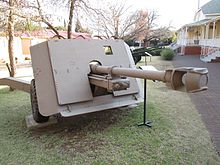
Back مدفع مضاد للدبابات Arabic Противотанково оръдие Bulgarian Canó antitancs Catalan Panzerabwehrkanone German Cañón antitanque Spanish توپ ضدتانک Persian Panssarintorjuntakanuuna Finnish Canon antichar French תותח נגד טנקים HE Senjata anti-tank ID

An anti-tank gun is a form of artillery designed to destroy tanks and other armoured fighting vehicles, normally from a static defensive position.[1] The development of specialized anti-tank munitions and anti-tank guns was prompted by the appearance of tanks during World War I.[2] To destroy hostile tanks, artillerymen often used field guns depressed to fire directly at their targets, but this practice expended too much valuable ammunition and was of increasingly limited effectiveness as tank armor became thicker.[2] The first dedicated anti-tank artillery began appearing in the 1920s, and by World War II was a common appearance in many European armies.[3] To penetrate armor, they fired specialized ammunition from longer barrels to achieve a higher muzzle velocity than field guns.[4] Most anti-tank guns were developed in the 1930s as improvements in tanks were noted,[5] and nearly every major arms manufacturer produced one type or another.[3]
Anti-tank guns deployed during World War II were often manned by specialist infantry rather than artillery crews, and issued to light infantry units accordingly.[5] The anti-tank guns of the 1920s and 1930s were of small caliber; nearly all major armies possessing them used 37 mm ammunition (the British Army used the slightly larger 40 mm 2-pounder gun).[2] As World War II progressed, the appearance of heavier tanks rendered these weapons obsolete, and anti-tank guns likewise began firing larger and more effective armor-piercing shot.[3] The development of the compact hollow charge projectile permanently altered anti-tank warfare, since this type of ammunition did not depend on a high muzzle velocity and could be fired from low-recoil, man-portable light weapons, such as the Panzerfaust and the American series of recoilless rifles.[3]
Although several large-caliber guns were developed during the war that were capable of knocking out the most heavily armored tanks, they proved expensive and difficult to conceal.[3] The later generation of low-recoil anti-tank weapons, which allowed projectiles the size of an artillery shell to be fired from the shoulder, was considered a far more viable option for arming infantry.[5] Recoilless rifles replaced most conventional anti-tank guns in the postwar period; nevertheless, the development of new anti-tank guns exhibiting similar low-recoil performance continued until the late 1950s in France, Belgium, and the Soviet Union.[6] A few Soviet designs saw combat well into the 1980s and 1990s.[7] The People's Republic of China was still producing towed anti-tank guns as late as 1988.[8]
- ^ OXFORD Advanced Lerner's DICTIONARY opf Current English, NEW EDITION, Cornelsen & OXFORD, A. S. Hornby, 5th edition, page 42.
- ^ a b c Norris, John (1997). Brassey's Modern Military Equipment: Anti-tank weapons. London: Brasseys UK Ltd. pp. 7–21. ISBN 978-1857531770.
- ^ a b c d e Gander, Terry; Chamberlain, Peter (1974). World War II Fact Files: Anti-tank Weapons. New York: Arco Publishing Company, Incorporated. pp. 1–6. ISBN 978-0668036078.
- ^ MILITÄRISCHES STUDIENGLOSAR ENGLISCH Teil II/ Teil III, Deutsch – Englisch, Abkürzung Begriff, Bundessprachenamt (Stand Januar 2001), page. 283, anti-tank ammunition.
- ^ a b c Rottman, Gordon (2005). World War II Infantry Anti-Tank Tactics. Oxford: Osprey Publishing. pp. 15–17. ISBN 978-1841768427.
- ^ Ogorkiewicz, Richard (1991). Technology of tanks, Volume 1 (1991 ed.). Macdonald and Jane's Publishers Ltd. pp. 70–71. ISBN 978-0710605955.
- ^ "Ratel teen tenk en". Port Elizabeth: International Veterans' Association/South African Forces Club. 2011. Archived from the original on 28 July 2012. Retrieved 20 September 2016.
- ^ "China – Ordnance". Jane's Defence Weekly: 161. 1988.
© MMXXIII Rich X Search. We shall prevail. All rights reserved. Rich X Search